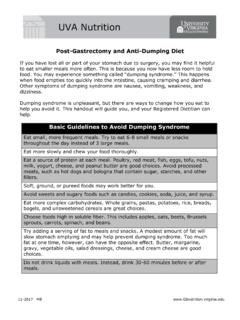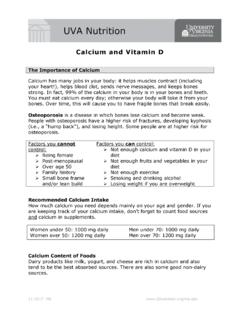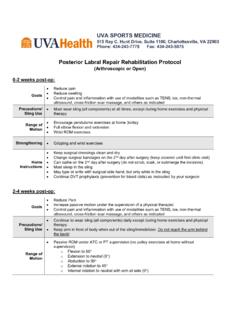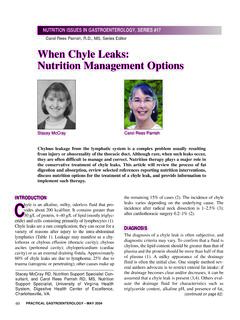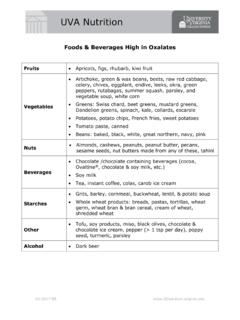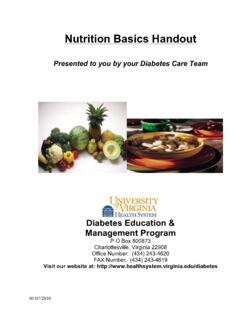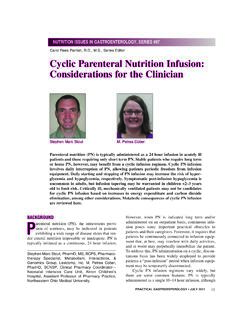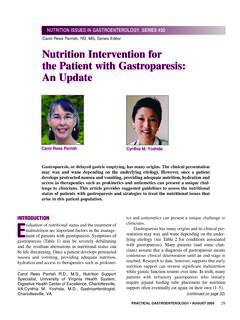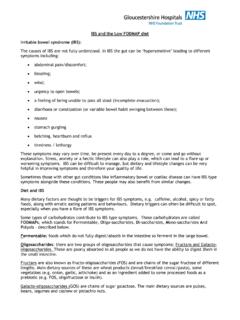Transcription of Diet in Non-Alcoholic Fatty Liver Disease
1 NUTRITION ISSUES IN GASTROENTEROLOGY, SERIES #191. Carol Rees Parrish, MS, RDN, Series Editor diet in Non-Alcoholic Fatty Liver Disease by Jennifer B. Miller, Zachary Henry Non-Alcoholic Fatty Liver Disease (NAFLD) is quickly becoming one of the leading causes of end stage Liver Disease , and many physicians will encounter these patients in the clinical setting. It has been proven that a hypercaloric diet , loaded with high fructose corn syrup is directly correlated with the amount of Fatty deposition in the Liver . A 7-10% weight loss has been associated with a decrease in Liver fat content and improvement in Liver fibrosis.
2 Therefore, the goal of treating these patients should be weight loss. This can be achieved with exercise, which alone has proven to be advantageous for the NAFLD patient, in concert with dietary change. Diets that reduce carbohydrates, especially high fructose corn syrup, and increase anti-oxidants have a positive impact on NAFLD. The following review highlights the epidemiology, pathogenesis, and treatment goals for patients with NAFLD. INTRODUCTION. N. onalcoholic Fatty Liver Disease (NAFLD) is a has been reported to be higher in patients with leading cause of end-stage Liver Disease and is metabolic syndrome, and autopsy data indicates considered the third-most common indication that NASH is at least six times more prevalent in for Liver transplantation in the United ,2 obese patients compared to lean NAFLD.
3 The term NAFLD encompasses the spectrum of is present in 65% of persons with Class I or II. Fatty Liver diseases including non-NASH Fatty Liver obesity (BMI kg/m2) and 85% of persons (NNFL), nonalcoholic steatohepatitis (NASH), with a BMI 40 ,6 NAFLD is strongly linked and NASH cirrhosis. NAFLD is defined by the to both insulin resistance and cardiovascular presence of 5% hepatic steatosis, confirmed by Disease and is considered to be the hepatic imaging or histology, and lack of secondary causes manifestation of the metabolic ,8 With of hepatic fat A meta-analysis of the increasing prevalence of metabolic syndrome over eight million patients estimated that the and consequently the NAFLD population, there overall global prevalence of NAFLD diagnosed by is an urgency to identify efficacious management imaging was The prevalence of NAFLD strategies.
4 As these patients are at risk to develop complications of end stage Liver Disease . Jennifer B. Miller, MD, GI Fellow, University of Virginia Division of Gastroenterology and Pathophysiology of NAFLD. Hepatology Zachary Henry, MD, MSc, Assistant The cornerstone of our current understanding of the Professor, University of Virginia Division of progression of hepatic steatosis to NASH fibrosis Gastroenterology and Hepatology, Charlottesville, VA. 24 PRACTICAL GASTROENTEROLOGY OCTOBER 2019. diet in Non-Alcoholic Fatty Liver Disease NUTRITION ISSUES IN GASTROENTEROLOGY, SERIES #191.
5 Was described by Day and colleagues as the 2- Liver enzymes, and hepatic inflammation; it may hit phenomenon. This hypothesis proposed that also improve A 7%-10% reduction in accumulation of fat in the Liver is followed by body weight results in improvement in histological an oxidative stress state resulting in Liver injury/ findings including lobular inflammation and inflammation and resultant scarring hepatocyte Small decreases in body In the hepatocyte mitochondria, free Fatty acids weight equate to more substantial decreases in undergo a process of oxidation, esterification and Liver fat.
6 And the method by which a patient loses synthesis into phospholipids and cholesterol esters, weight is In a prospective trial of 293. which are exported from the Liver as very low patients on a low-fat hypocaloric diet , 750 kcal/d density lipoprotein. Accumulation of hepatic fat less than their daily energy needed, a greater than can overwhelm the above described process. This 10% weight loss resulted in a reduced fibrosis hepatic fat accumulation can occur by different score of at least 1 point in 13 of 16 (81%) patients mechanisms including delivery from the intestine with baseline This study along with as chylomicrons, delivery from lipolysis through many others supports the fact that weight loss the action of lipase on insulin resistant adipocytes is independently linked to an improvement in and thirdly, de novo A recent study histological outcomes in patients with NAFLD.
7 Revealed that patients with higher hepatic fat It is important to also recognize that physical content derive a greater proportion of Liver fat activity, independent of weight loss, can improve from de novo lipogenesis, compared to matched Fatty Liver Disease by reducing hepatic fat content. controls. Interestingly, specific components of the Studies have shown that exercise improves the modern American diet , specifically high fructose body's peripheral sensitivity to insulin. This corn syrup, have been shown to augment the decreases the action of lipase, resulting in less amount of hepatic de novo lipogenesis in patients adipocyte lipolysis and less delivery of free Fatty with acids to the Liver .
8 Exercise has also been shown to decrease the amount of de novo lipogenesis Therapies for NAFLD in patients dedicated to an exercise The prognosis of a patient with NAFLD is Therefore, in addition to encouraging patients variable, and determining that patient's risk to follow a healthy diet , clinicians should also for Liver related morbidity is essential to gauge encourage dedicated exercise programs to therapeutic intervention. Ekstedt et al. performed maximize potential impact on NAFLD as well as a thirty-three year cohort study evaluating 229 metabolic syndrome in general.
9 Biopsy proven NAFLD patients, which found that patients with NAFLD had an increased mortality Specific Diets in NAFLD. compared with the referenced population (HR Lifestyle modifications have shown proven benefit , CI , P= ). The causes of death in patients with NAFLD. Accomplishing weight in patients with NAFLD included cardiovascular loss can occur through healthy dietary modifications Disease (41%), non-gastrointestinal malignancy that decrease calories and result in a net negative (19%) and hepatocellular carcinoma (5%). Those energy balance. In order to achieve this, expert patients with baseline fibrosis stage 3 or 4 (per opinion recommends patients should undergo biopsy) had the worst Given the a multidisciplinary approach, which includes complex underlying physiology of NAFLD, there education by a registered dietitian nutritionist.
10 Are many potential targets for therapeutic drugs. Overall, there are limited data to support one Unfortunately, medical therapies up to now have particular diet over another for NAFLD due to been unsuccessful in reversing fibrosis and have small numbers of patients in lifestyle studies. only been marginally effective at improving the In addition, a recent large trial suggested that a underlying components of NAFLD steatosis, patient's response to a particular diet may be based inflammation, and balloon cell upon individualized factors as of yet unidentified Weight reduction in patients with NAFLD and predicting success is more difficult than leads to a decrease in Liver fat content, serum previously However, we will present PRACTICAL GASTROENTEROLOGY OCTOBER 2019 25.
